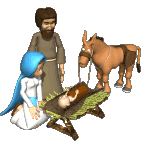

December 25, 2004

The Confusion of Christmas Day
As I sat down on Christmas Day, determined to prepare a simple birth announcement for Jesus, I encountered some problems I was not prepared for. The trouble began when I tried to decide what to call him. Was he known as the Christ at the time of his birth? If not Jesus Christ, what was his last name? One assumes that Joseph did not have one in the same sense that we have last names today, given the custom of the time. Joseph was known to be of the House of David, and he was the son of Jacob, so maybe he was a Jacobson. Perhaps the father of Jesus was known as Joseph of Nazareth, that being his place of residence at the time. Surely he was not the victim of one of those hyphenated last names that seem so popular in these times. Being anything but a biblical scholar, I had not a clue as to what Joseph's actual last name might have been. So I just put down baby Jesus. It seemed weak but it was the best I could do.
The next problem was what to put in for the weight and the length of the new child. One wonders if it was even the custom in those days to share this knowledge with the good tidings. It certainly is today. Consider where one might go to find such information; it would seem that the Bible is the only source, barring some recent discovery in one of those caves near the Dead Sea. But to my knowledge the Bible, which is usually so copious in its detail, is silent on the subject of Jesus's birth length and weight. We do know that he was a robust newborn. Since this was Mary's first child, and newborn children were likely somewhat smaller even in these ancient times, I took a guess at 7 lbs. 2 oz. and 19 inches.
Next there was the issue of the place of birth. Although there seems little doubt that Jesus was born in Bethlehem, and that the birth took place in a stable, given the importance of animals and livestock in biblical times, there must have been dozens of stables even in the little town of Bethlehem. One would assume that the stables bore the same name as their owners. Little is known, however, about the particular stable where Jesus was born. Without any information on the subject, I arbitrarily chose the name of Humble Stable, since this seemed most appropriate to the circumstances of the birth of this remarkable child. One wonders if the proud parents would have put down the place of birth at all, given the fact that it would place their newborn child in dire jeopardy. King Herod was already well aware of the signs and rumors that portended the arrival of one who might challenge his authority. He was soon to issue a decree that would cause the death of numerous male infants, and give rise to the flight of Joseph, Mary, and Jesus to Egypt.
Then I began to ponder about the time of day when Jesus drew his first breath. It seemed reasonable to assume that it was nighttime when Mary gave birth, given the accounts of the bright light that shone all around at the time of the event. While the interior of the stable may have been dim even in the light of day, the brightness of the light that attended the blessed moment would have been even more dramatic in the dark of night. I arbitrarily chose as the time an hour or so before dawn, and used this in the birth announcement.
Finally, and most difficult of all, was selecting the date and year of the birth. This choice on the surface seems deceptively simple. We are accustomed to the date of December 25, and initially presume that the year must have been the year A.D. 1. Neither of these assumptions turn out to be trouble-free. Indeed, the Jewish lunar calendar that was in use at the time of the birth of Jesus was somewhat arbitrary, and depended upon two reliable reports of sightings of the new moon reaching the proper official promptly so that he could proclaim the beginning of the month. To make matters worse, a Roman emperor who converted to Christianity arbitrarily chose a date for the birth of Jesus to coincide with the important pagan rituals that celebrated the winter solstice. There also seems to be considerable reason behind the position held by some that Jesus was born in the spring instead of the winter.
To further muddy these waters, the current Jewish calendar was not standardized until the fourth century when Hillel II established a fixed calendar, and the Gregorian calendar that we in the USA rely on was adjusted by the recommendations of Pope Gregory's calendar commission on 1582 February 24, when ten days were deleted from the calendar, so that 1582 October 4 was followed by 1582 October 15. When (in desperation) I tried to calculate the Hebrew calendar equivalent to the currently observed December 25 date, there was no assurance that the answer I was getting was correct. The date I finally settled on was only a half a step removed from a random guess.
Given all the heroic assumptions that had to be made by your humble servant in order to create a simple birth announcement for the most important blessed event in the history of Western civilization, there seems to William to be one more good reason why so many Christians should fall on their knees on Christmas Day.

 to Journal Main Page
to Journal Main Page
